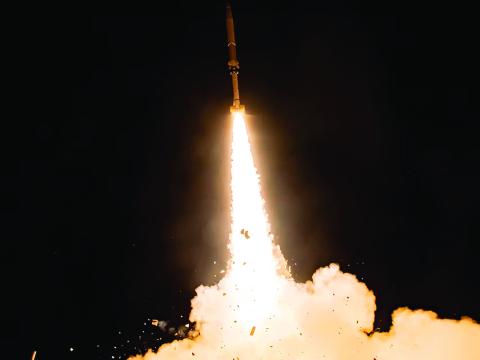Space Joins Land, Sea and Air
The fourth domain is becoming an arena of operations in its own right.
Military space activities increasingly are resembling their more terrestrial counterparts as their presence grows in military operations. The aboveworldly realm now has its own specific communications networks, surveillance and reconnaissance sensors and even weather reports. Soon, it may feature new reusable transport systems and weapons designed to maintain supremacy in the highest frontier.
Some of these existing and future space assets will supplant, or even replace, systems normally based on Earth or in the air that support military operations. Others will serve the space domain exclusively. Ultimately, space will take its place alongside land, sea and air as the fourth operational arena for military forces.
Gen. Ralph E. Eberhart, USAF, is the commander in chief (CINC), U.S. Space Command; commander in chief, North American Aerospace Defense Command (NORAD); and commander, U.S. Air Force Space Command, Peterson Airforce Base, Colorado. In a SIGNAL interview, Gen. Eberhart describes the changes that his space commands are undergoing as a result of both maturing disciplines and new technologies. “I don’t view space as a new medium on the block,” he emphasizes. “I believe that the benefits of operating from and through space are becoming increasingly obvious to all of us.
“You hear a lot about the integration of air and space, which I’m all for. But I also push for the integration of space and land and of space and maritime. What space offers is important to airpower, to our soldiers, to our sailors and to our marines,” he declares.
“I don’t view this as a zero-sum game, where space becomes more important so therefore air, land or sea become less important,” the general emphasizes.
Gen. Eberhart continues that, over time, many activities will be done more effectively from space. Some traditional land, sea and air activities will move to space as technologies mature and costs become more affordable.
He cites the ongoing transition from missile warning to missile defense as a discipline that will require better space-based capabilities. Launch detection, tracking and interception all will require improved space assets that will work in concert with ground-based counterparts.
“A space-based radar will be very important and very effective in the future, especially in terms of moving target indicators,” Gen. Eberhart predicts. This includes both ground and air moving targets. Some of the functions performed by the Joint Surveillance Targeting Attack Radar System (JointSTARS) will migrate to space to operate in concert with the JointSTARS aircraft. The same complementary migration will occur with the airborne warning and control system (AWACS), he continues.
Another system that likely will assume its position in orbit is the space-based laser. Gen. Eberhart describes its technology as “very achievable,” and its deployment will provide an additional capability for intercepting ballistic missiles, especially in the ascent phase of their flight.
Communications will continue to flourish in the orbital realm, and the general offers that satellite communications will improve across the entire spectrum. He foresees these systems increasingly interoperating with terrestrial-based communications that rely on fiber, which can deliver huge amounts of badly needed bandwidth. However, the mobile aspect of U.S. force deployments likely will mandate continued satellite links.
Space control, especially situational awareness, is moving from what traditionally has been exclusively ground-based assets. Gen. Eberhart foresees more of this discipline taking the form of a space-to-space aspect, particularly in surveillance. On-orbit satellites will help characterize the orbits of other satellites to generate an extensive database that the general likens to the national air traffic control system—“an FAA [Federal Aviation Administration] of space.”
Maintaining space supremacy may well depend on the development of a reusable launch vehicle for the military, and the United States is lacking in that arena. “I’m very concerned that we are not progressing in the development of a reusable launch vehicle as I believe we should,” Gen. Eberhart asserts. He adds that this is not intended as a criticism of the efforts of the past 10 years, but U.S. Defense Department concentration on expendable launch vehicles has left a void that needs to be addressed.
“What we found over the past seven years is that what NASA is interested in for reusable launch vehicles is different than what the Defense Department is interested in,” he allows. This largely involves payloads, frequency of flights, responsiveness and cost. He expresses discomfort that “our course is not one that I am convinced is the right course,” particularly at the space commands. “We are just going to have to determine the way ahead and then invest in the needed technologies—it is very important in terms of force enhancement and space control.”
The U.S. Space Command’s mission has not changed greatly since September 11, the general notes. The command is still carrying out the same basic missions in force enhancement, space control and space support. Methodologies have changed, however. With the onset of operation Enduring Freedom and operation Noble Eagle, the command has become a supporting CINC for these two operations. This support has been stepped up in both volume and frequency.
For operation Enduring Freedom, the U.S. Space Command is tapping several areas of responsibility to support U.S. Central Command forces engaged in Afghanistan. Particular attention has been paid to the Global Positioning System (GPS), which has played a key role in guiding both personnel and munitions to Taliban and al Qaida targets in Afghanistan. Gen. Eberhart notes that the command is constantly updating the GPS satellites that are in the field of view in the Afghanistan area.
Another key concern is bandwidth. The general relates that the U.S. Space Command has worked to ensure that warfighters in that region have sufficient communications capabilities, especially through satellites.
Weather data is another vital piece of the operational puzzle being provided by the U.S. Space Command. Gen. Eberhart explains that this information can affect the choice of weapons for a target and the platform that delivers them. Updated weather information now is being provided to operation Enduring Freedom forces more frequently. This includes space weather, which can degrade or disrupt various forms of communications.
Supporting operation Noble Eagle represented a significant shift in emphasis for NORAD. The command’s air defense posture traditionally was aligned to counter external threats to North America. This involved detecting and identifying all aircraft entering North American airspace and intercepting potentially threatening inbound aircraft. Over time, it grew to encompass the broader aerospace dimension of missile launch and space event detection. Now, the command is looking out for potentially hostile internal air threats such as hijacked aircraft.
Carrying out this new internal mission without sacrificing any traditional external vigilance required increased resources. Gen. Eberhart relates that, prior to September 11, NORAD would have 14 aircraft on alert at seven different sites in the 48 contiguous states. Now, the command has more than 100 aircraft on alert in the same area of operations.
In 2000, NORAD scrambled fighter aircraft seven times—including exercises—from September 10 through October 10. During that same time period in 2001, which includes the aircraft terror attacks, fighter aircraft were scrambled 41 times, and 48 fighter patrols were diverted from ongoing combat air patrols to assess tracks of interest. This constitutes a total of 89 events for that 30-day period. Some Air National Guard units have flown one-third of their yearly flying program in just one month.
To fulfill the new requirements for internal aerospace defense, NORAD has tapped the resources and expertise gleaned from years of external defense of the continent. The command is generating a situational awareness picture of the interior along the lines of its traditional external situational awareness picture.
The command also has increased its interaction and coordination with the U.S. Federal Aviation Administration (FAA). Now, whenever the FAA detects an air traffic anomaly, NORAD knows about it immediately, the general relates.
The general adds that NORAD has operated “seamlessly” with the NATO AWACS aircraft that now are patrolling North American skies to help generate the continental situational awareness picture. These alliance aircraft were deployed to the United States under Article 5 of the NATO charter as U.S. AWACS were deployed overseas under operation Enduring Freedom.
Computer network defense is a key aspect of the U.S. Space Command’s mission of computer network operations. The connectivity inherent in U.S. forces provides a particular challenge, Gen. Eberhart notes. Many unclassified military networks are connected to the Internet, which provides global access for potential foes. In many cases, hackers and other cyberspace adversaries cannot even be tracked to their points of origin.
Despite U.S. forces conducting combat operations on foreign soil, U.S. military networks have not been inundated with computer attacks. In fact, the command has not had any increase in computer network attacks since September 11, Gen. Eberhart attests.
The general continues that many computer network defense issues may be addressed in current legislation. “Computer network policy and law have lagged in terms of the additional systems, the sophistication of those systems and their proliferation over time,” he charges. For example, law enforcement organizations can engage in operations with telephone network switches that they are prohibited from doing with computer networks. “Over time, we will have to come to grips with that so that law enforcement can bring some of these computer hackers to justice,” the general declares. He adds that both the Bush administration and Congress understand this problem and are working to include needed remedies in budget authorizations.




Comments